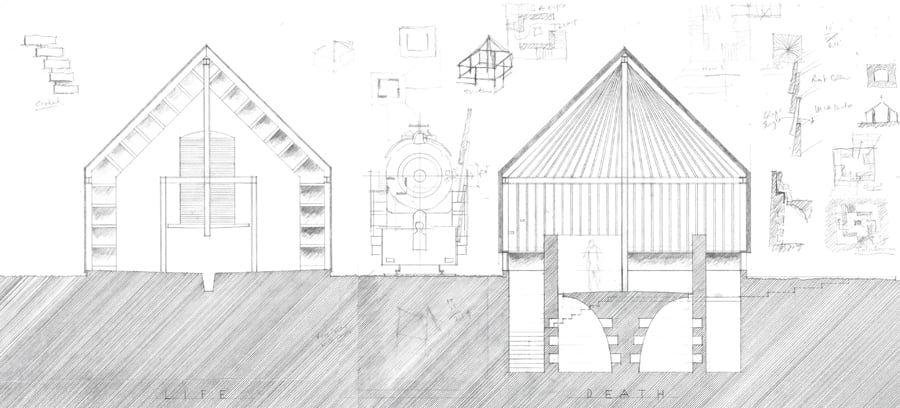
August 28, 2020
Memory Becomes a Path to Creativity for Robert Hutchison Architecture
The architect’s “Memory Houses” is a speculative project comprising eight unbuilt structures designed for a site on Maryland’s Eastern Shore.

Robert Hutchison’s Seattle-based firm spent over five years working on an unusual set of structures on the on the Eastern Shore of Maryland called “Memory Houses.” Each of the eight buildings fit a distinctive typology: dwelling, chapel, lighthouse, boat house, bell tower, round house, signal house, and columbarium. Most unexpectedly, these “Memory Houses” were fully realized through extensive drawings and models, but none were ever built; the entire project was conceptual.
In the Pacific northwest, Robert Hutchison Architecture is known for Scandinavian-influenced residential projects that speak to their surroundings, such as Courtyard House on the River and Cantilever House. But, the modest firm of four also devotes about one quarter of their practice to conceptual “investigations” that are designed but never constructed. Noting Douglas Darden’s Condemned Building (1993) as an influence, Hutchison told Metropolis, “I’ve always been interested in pushing the boundaries of what it means to practice architecture. ‘Memory Houses’ became one of those vehicles for me, along with installations, teaching and conceptual work.” “Memory Houses” is documented in a publication of the same title (Arquine, 2019) that features drawings, models, digital renderings, and essays that unpack the project that serves as a unique foundation for continued creativity within the firm’s practice.

In 2015, the two-year-old studio was seeking to expand their work beyond residential projects. At the same time Hutchison was confronting his personal grief surrounding his father’s dementia and associated memory loss. At this juncture, he found himself returning to a project he and his father had worked on twenty-five years prior: the design for a winery on Maryland’s Eastern Shore that was never built. “As a means to retain a conversation with my father in place of the one I could no longer have, I decided to design a new building adjacent to the winery, a chapel and a columbarium intended to hold his remains,” Hutchison writes in Memory Houses.

While Hutchison did not intend to continue the speculative project beyond those initial designs, he soon found himself bringing his staff into his process, which continued to grow into eight structures. He explains, “It became a fascinating, hyper-architectural conversation between all of us, sometimes lasting for hours over wine, talking about things that don’t always come up with more conventional projects, where you’re working with clients and budgets and just trying to get your permit in.” In what became a collaborative working method, Hutchison sketched the initial “Memory House” building concepts and translated them into formal drawings that he would then handoff to staff, including Xiaoxi Jiao, who oversaw construction and coordination of most of the project’s intricate models.
As “Memory Houses” expanded in scope to include the publication and two exhibitions, the firm had the opportunity to use techniques that don’t often arise in other work, such as re-envisioning the designs as ceramic models for an exhibition in Mexico City. “Design can be many different things. It can be what I was doing at the beginning when I was sketching and creating the conceptual direction of the building, but it can also be about translating a lighthouse into a ceramic form,” says Hutchison, speaking to the lasting effects of the project. “These side design projects became opportunities for us to engage with different ways of thinking that continue to inform our practice.”
You may also enjoy “Designers on Holiday Puts Adventure and Whimsy Back into Sustainable Design”
Would you like to comment on this article? Send your thoughts to: [email protected]
Register here for Metropolis Webinars
Connect with experts and design leaders on the most important conversations of the day.















